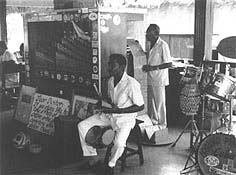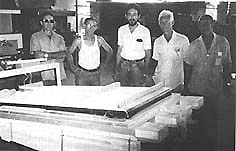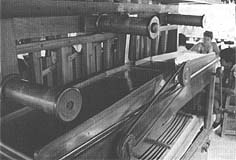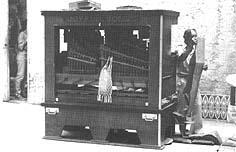




All rights reserved. This document, or any part of it, must not be reproduced in any format without prior written permission of the Fair Organ Preservation Society
©2025 - Fair Organ Preservation Society


Caribbean Dream
by Trevor Taylor
For many years I have been trying to visit Cuba and this year has been the first year of direct flights from Britain to this Caribbean Island. knowing that the Americans were putting it about that Fidel Castro was the last of the evil empire of communism and a total economic blockade was in place, we were not sure what we were going to find after the ten hour flight.
We had arranged to take an eight day tour of the Island as it is some 1,000 miles long and 60 miles wide, followed by a seven day stop in what was to be an idyllic setting on the Caribbean coast line. One had been told to expect cigars, rum and 1950s and 1960s American cars and probably little else. What we did not expect to find was a wonderful welcome with friendly people, exotic fresh fruit and a country which is spotlessly clean and Organs. The temperature at midday is around 110 deg F in June with a humidity level of about 80% which means that siestas are essential. Together with wonderful air conditioning, it really makes you not want to live in the past. We spent four days touring wonderful old Spanish style towns left over from the 16th Century, which have changed very very little; this possibly due to the fact that with the blockade in place, such basic items as paint and building materials are unobtainable, which adds to the Olde Worlde Charm. In towns like Trinidad you really expect to meet marauding pirates coming round the next corner; maybe Captain Morgan's ghost lives on today. However, I digress.
 |
While in the north of the Island, some 50 miles from Havana and not a town in sight, we visited an underground river and were told that we were to have lunch at a farmhouse in the mountains. Imagine my surprise, when stepping out of the air-conditioned coach into a clearing with a shack with open sides and Palm leaves for a roof, to hear the strain of what I thought was a Gavioli fair organ. Were my ears deceiving me? Had those mad dreams that one has about discovering organs in odd places of the world really come true or was it the heat and humidity at last getting to me? Maybe it was the rum in all its different disguises, but the music kept playing as we entered the restaurant and I felt that my eyes were deceiving me, as I spied a very large wooden contraption with pipes everywhere making this wonderful sound. The comments from my wife were ones which I suspect many of us had heard in the past, "Oh no! Not another b... Organ. Can you ever get away from them?" |
All through lunch I sat listening to this wonderful machine trying to decide what vintage, what make and what size. It appeared to be in origin about 1890-1900, was certainly of a large key size and sounded very much like a Gavioli, Marenghi or Limonaire. It had no percussion on it; this being supplied by a steel band of six players. It appeared to need a minimum of four people to play it; one turning the bellows, one turning the key frame, one at each side working the register. When it came towards the end of the meal I could contain myself no longer, having button-holed the interpreter to take me to the man in charge of the organ, I was greeted and introduced to all the players as a long lost friend and given the opportunity to play this magnificent machine. I discovered that it was a 67-key organ and, to my great surprise, made in Cuba some 10 years previously. On further enquiries I was told that the factory still existed and it was in a city only 30 miles from where I would be staying the next week.
The one thing that can be said about the Communist system is that once it gets into gear everything is arranged. Two days later, sitting under a palm tree on a beautiful golden sandy beach, I was informed by the government representative that a car would be waiting for me the following morning and I should not worry as everything would be laid on for a visit to the Organ Works.
At 8 o'clock the following morning I met my official interpreter and guide for the day. He introduced me to the taxi driver who, like all good taxi drivers, spent the 30 miles in wonderful conversation. One piece that interested me more than anything else was to hear the organ works had been tuning an organ the previous evening, according to the taxi driver who claimed he lived over the road.
The first port of call is always the party headquarters where we met the Managing Director who escorted us to the factory. On arrival at the main office, I was introduced to the Works Manager, the Workshop Foreman and, most important of all, the Chairman of the Workers' Representatives (Shop Steward). These gentlemen explained to me that their organ works was founded in 1891, employed 32 people and produced two sizes of organs. One 55-key and the larger size 67-key. It would appear that in the late 1800s, Limonaire organs from France were imported into Cuba and the factory was set up copying these organs.
A fascinating tour of the Factory then took place and in three and a half hours I was allowed to see every aspect of organ making. I could not believe my eyes; the machinery they were using dated from the turn of the century. Such machines would be banned under health and safety regulations anywhere else in the world. The keys for the key frame were individually made by hand rather than stamped. The pipes were made in set combinations and were stored in a rack so that, when an organ was put together, a rank of pipes would be taken out at random and fitted very much on a production line basis. The only concession to modern materials is the case which is made of plywood. When the organ is fully assembled and ready to play it is tested for 50 hours before leaving the workshop.
| The organ has an interesting system of operation whereby one man turns the bellows which are double acting and 8 feet in length. This requires a certain amount of weight lifting and training if you are going to keep it up for any length of time. One man works the key frame, which is revolved by a handle, being turned to the speed that is required for any particular part of tunes being played; with Latin music this does vary. The registers are fitted on straight slides at either side of the organ. Most organs are fitted with 16 manually operated registers, this requiring two men, one each side, to operate it. In addition to this, you require one man to operate the book music which is fed through the key frame over four rollers placed around the perimeter of the organ which returns the music to the man who is feeding it in.(Photo Below) So, one could say this is a six man operated organ with no monkey, but what about drums, percussion etc? As we are dealing with Latin American music, a six piece band accompanies the organ, which, as you can imagine, makes a wonderful and memorable big sound. |
 Workers and bellows |
 Key frame and return rollers |
I was fascinated to see how the books of music were being produced. The card principal is the same but whereas we lay a master over the card to mark the holes, the two ladies that were producing the music were using a set square and pencil. The musical arrangement had been made into a scroll which was propped up in front of the music marker, straight lines were ruled down the card and the length of the note was marked with the set square. This was then taken to a very old punching machine where each individual note was produced. |
As I was touring the factory I was told that the present batch of four organs were to be 55-note organs which were destined for China. The previous batch of five 67-note organs had all gone to South American countries. It was explained to me that the organs are delivered, in the main, to schools and colleges. They were then used as a teaching aid; all Cubans play a musical instrument. There are no musical scores available in Cuba and an instrument and tune is learnt along with the organ by memorising the particular tunes and arrangements. I can only imagine what it would have been like in my own school if this arrangement had been available. The only thing I can remember doing was learning Sea Shanties.
At the end of the tour I was given an organ recital which meant that the whole of the factory stopped work. Most of the workers played the organ and the accompanying rhythm, but what I didn't realise was that the moment that the organ started the school next door stopped teaching and all the children came through to the factory to listen. What appeared to be the whole of the city gathered in the street outside the factory gates, not only blocking the road but bringing traffic to a halt for a long distance around, and the music was all for my benefit! I really felt like the King of the Castle.
Various combinations were tried out after I requested to hear different sounds, this lasting for some 50 minutes to an hour, in which I was totally fascinated. At the end of this recital and going back to the office I felt it was appropriate to offer everyone a beer. If you buy beer in the hotel, it costs two dollars a bottle but in Cuba there is a black market for dollar goods. The official exchange rate is one lira for one dollar; the unofficial exchange rate is 120 lira for one dollar. So having handed over my dollars thinking it would buy one crate of beer, surprise, surprise, when 14 crates of beer arrived and everybody thought I was an excellent fellow and must be one of the richest men in the world.
My tour did not finish there as, having spent four hours in the organ works and being made more than welcome, I was then informed that the local Cathedral, which was closed at the time of the revolution, had the oldest organ in Cuba and that arrangements had been made for me to see this instrument. Once again, imagine my surprise when being taken down to the city to what appeared to be a boarded up and derelict building, I was ushered into a little door at the rear to be met by the local priest who was extremely apologetic that only two manuals of his four manual organ were working. On entering the old Cathedral, it was like walking into a time warp; the magnificent frescos were still there in all their glory together with a magnificent organ which, 1 was informed, came from Spain in about 1690. Although this organ had not been touched for more than 30 years, it still made a magnificent sound. After a short recital, I said goodbye to the worthy organist and wished him well when his church re-opens.
 Street music in Cuba |
I was then taken to a local Arts Centre which was run as a co-operative by the artists themselves. They, too, had a magnificent Cuban organ which was played for me for the next one and a half hours non-stop. As you can imagine, in a heat of some 100 deg F with a high humidity, this was no mean feat; amazing what can be done when the beer flows. Returning to my hotel in the late afternoon and bidding farewell to my guide and interpreter I could not believe the dream had actually come true. I would urge all of you who would like a holiday in the Caribbean, combined with the best of European organ music from a bygone age, to go to Cuba as soon as possible as I believe that, with the opening up of the tourist industry, this friendly and wonderful experience will not remain for much longer. |
© Trevor Taylor, 1995
Originally published in edition 1 of The Key Frame 1995.
